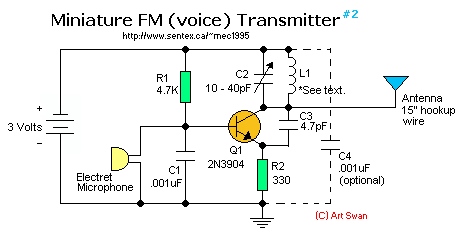
Parts List:
R1 = 4.7K Q1 = 2N3904
R2 = 330 ohm L1 = see text
C1 = 0.001uF (1nF) Electret mike, antenna, 3V battery (button cell)
C2 = 10-40pF
C3 = 4.7pF
Construction:
This is another easy-to-build miniature transmitter that uses a minimum of parts. Construction is straight forward and
non-critical. Although this design uses a 3-volt power source (such as a lithium coin or button cell), a 9-volt battery
can be used, instead, by increasing the value of R1 to 15K and R2 to 1K. C4 is an optional RF bypass capacitor that
may help improve performance and increase the range a bit. Experiment to find best results.
L1 was made by stripping 22 gauge hookup wire of it's insulation, then wrapping it in the grooves of the screw threads
of a 1/4 diameter bolt, and then back-screwing the bolt out of the resulting coil. 8 turns were made around the bolt.
By wrapping the turns in the threads, a uniform seperation was made between the coil windings.
If you decide to substitute transistors with something similar you already have, it maybe necessary adjust the collector
voltage of Q1 by changing the value of R2 or R3 (because you change transistors, it changes this bias on the base of Q1).
It should be about 1/2 the supply voltage (about 4 or 5v).
Notes:
The default for the capacitors type is ceramic, preferably the npo 1% type or equivalent. But basically nothing
critical here. Use any capacitor you have laying arround, but no electrolytic or
tantalum caps. Don't go out and rush to the store. Most parts can be salvaged from somewhere. Only if you intend to
use this circuit outside the home you may want to select more temperature stable capacitors.
I'm not sure about the range. With the 3V supply it is probably around 100 feet or so. The 9V supply will beef up
the range considerably, again not tested, but probably in the 300 feet range or so.
To find the signal on your receiver, make sure there is a signal coming into the microphone, otherwise the circuit
won't work. I use an old mechanical alarm clock (you know, with those two large bells on it). I put this clock by
the microphone which picks up the loud tick-tock. I'm sure you get the idea... Or you can just lightly tap the
microphone while searching for the location of the signal on your receiver.
Back to Circuits page

